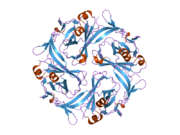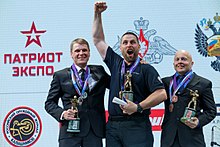Kir2.1
Kir2.1| KCNJ2 | |||||||||||||||||||||||||
|---|---|---|---|---|---|---|---|---|---|---|---|---|---|---|---|---|---|---|---|---|---|---|---|---|---|
 | |||||||||||||||||||||||||
| 식별자 | |||||||||||||||||||||||||
| 별칭 | KCNJ2, ATFB9, HHBIRK1, HHIRK1, IRK1, KIR2.1, LQT7, SQT3, 칼륨 전압 게이트 채널 서브 패밀리 J 멤버 2, 내부 정류 채널 서브 패밀리 J 멤버 2 | ||||||||||||||||||||||||
| 외부 ID | OMIM: 600681 MGI: 104744 HomoloGene: 20249 GeneCard: KCNJ2 | ||||||||||||||||||||||||
| |||||||||||||||||||||||||
| |||||||||||||||||||||||||
| |||||||||||||||||||||||||
| 직교체 | |||||||||||||||||||||||||
| 종 | 인간 | 마우스 | |||||||||||||||||||||||
| 엔트레스 | |||||||||||||||||||||||||
| 앙상블 | |||||||||||||||||||||||||
| 유니프로트 | |||||||||||||||||||||||||
| RefSeq(mRNA) | |||||||||||||||||||||||||
| RefSeq(단백질) | |||||||||||||||||||||||||
| 위치(UCSC) | Cr 17: 70.17 – 70.18Mb | Chr 11: 110.96 – 110.97Mb | |||||||||||||||||||||||
| PubMed 검색 | [3] | [4] | |||||||||||||||||||||||
| 위키다타 | |||||||||||||||||||||||||
| |||||||||||||||||||||||||
K2ir.1 내정 칼륨 이온 채널은 KCNJ2 유전자에 의해 인코딩된 지질 게이트 이온 채널이다.[5][6][7][8]
임상적 유의성
이 유전자의 결함은 안데르센타윌 증후군과 관련이 있다.[9]
KCNJ2 유전자의 돌연변이도 짧은 QT 증후군을 일으키는 것으로 나타났다.[10]
연구 중
신경유전학에서 Kir2.1은 뉴런을 억제하기 위해 Drosophila 연구에 사용된다. 이 채널의 과도한 압착은 세포를 과극화시키기 때문이다.
광유전학에서는 멤브레인 국산화 개선을 위해 Kir2.1의 인신매매 순서가 할로호돕신(Halorhodopsin)에 추가됐다.결과 단백질 eNpHR3.0은 광유전학 연구에 사용되어 빛으로 뉴런을 억제한다.[11]
인간 HEK293 세포에서 Kir2.1 유전자의 발현은 일시적인 외부 전류를 유도하여 칼륨의 반전 잠재력에 가까운 일정한 막 전위를 생성한다.[12]
상호작용
Kir2.1은 다음과 상호 작용하는 것으로 나타났다.
참조
- ^ a b c GRCh38: 앙상블 릴리스 89: ENSG00000123700 - 앙상블, 2017년 5월
- ^ a b c GRCm38: 앙상블 릴리스 89: ENSMUSG000041695 - 앙상블, 2017년 5월
- ^ "Human PubMed Reference:". National Center for Biotechnology Information, U.S. National Library of Medicine.
- ^ "Mouse PubMed Reference:". National Center for Biotechnology Information, U.S. National Library of Medicine.
- ^ Hansen, SB (May 2015). "Lipid agonism: The PIP2 paradigm of ligand-gated ion channels". Biochimica et Biophysica Acta (BBA) - Molecular and Cell Biology of Lipids. 1851 (5): 620–8. doi:10.1016/j.bbalip.2015.01.011. PMC 4540326. PMID 25633344.
- ^ Raab-Graham KF, Radeke CM, Vandenberg CA (1994). "Molecular cloning and expression of a human heart inward rectifier potassium channel". NeuroReport. 5 (18): 2501–5. doi:10.1097/00001756-199412000-00024. PMID 7696590.
- ^ Derst C, Karschin C, Wischmeyer E, Hirsch JR, Preisig-Müller R, Rajan S, Engel H, Grzeschik K, Daut J, Karschin A (2001). "Genetic and functional linkage of Kir5.1 and Kir2.1 channel subunits". FEBS Lett. 491 (3): 305–11. doi:10.1016/S0014-5793(01)02202-5. PMID 11240146. S2CID 14452157.
- ^ Kubo Y, Adelman JP, Clapham DE, Jan LY, Karschin A, Kurachi Y, Lazdunski M, Nichols CG, Seino S, Vandenberg CA (2005). "International Union of Pharmacology. LIV. Nomenclature and molecular relationships of inwardly rectifying potassium channels". Pharmacol. Rev. 57 (4): 509–26. doi:10.1124/pr.57.4.11. PMID 16382105. S2CID 11588492.
- ^ Donaldson MR, Yoon G, Fu YH, Ptacek LJ (2004). "Andersen-Tawil syndrome: a model of clinical variability, pleiotropy, and genetic heterogeneity". Ann. Med. 36 Suppl 1: 92–7. doi:10.1080/17431380410032490. PMID 15176430. S2CID 7362563.
- ^ Priori SG, Pandit SV, Rivolta I, Berenfeld O, Ronchetti E, Dhamoon A, Napolitano C, Anumonwo J, di Barletta MR, Gudapakkam S, Bosi G, Stramba-Badiale M, Jalife J (April 2005). "A novel form of short QT syndrome (SQT3) is caused by a mutation in the KCNJ2 gene". Circ. Res. 96 (7): 800–7. doi:10.1161/01.RES.0000162101.76263.8c. PMID 15761194.
- ^ Gradinaru V, Zhang F, Ramakrishnan C, Mattis J, Prakash R, Diester I, Goshen I, Thompson KR, Deisseroth K (April 2010). "Molecular and cellular approaches for diversifying and extending optogenetics". Cell. 141 (1): 154–65. doi:10.1016/j.cell.2010.02.037. PMC 4160532. PMID 20303157.
- ^ Zhang, De-Yong; Lau, Chu-Pak; Li, Gui-Rong (2009-04-01). "Human Kir2.1 channel carries a transient outward potassium current with inward rectification". Pflügers Archiv: European Journal of Physiology. 457 (6): 1275–1285. doi:10.1007/s00424-008-0608-0. ISSN 1432-2013. PMID 19002489. S2CID 3120804.
- ^ Nehring RB, Wischmeyer E, Döring F, Veh RW, Sheng M, Karschin A (2000). "Neuronal inwardly rectifying K(+) channels differentially couple to PDZ proteins of the PSD-95/SAP90 family". J. Neurosci. 20 (1): 156–62. doi:10.1523/JNEUROSCI.20-01-00156.2000. PMC 6774109. PMID 10627592.
- ^ Kurschner C, Yuzaki M (1999). "Neuronal interleukin-16 (NIL-16): a dual function PDZ domain protein". J. Neurosci. 19 (18): 7770–80. doi:10.1523/JNEUROSCI.19-18-07770.1999. PMC 6782450. PMID 10479680.
- ^ Grishin A, Li H, Levitan ES, Zaks-Makhina E (2006). "Identification of gamma-aminobutyric acid receptor-interacting factor 1 (TRAK2) as a trafficking factor for the K+ channel Kir2.1". J. Biol. Chem. 281 (40): 30104–11. doi:10.1074/jbc.M602439200. PMID 16895905.
추가 읽기
- Kubo Y, Adelman JP, Clapham DE, et al. (2006). "International Union of Pharmacology. LIV. Nomenclature and molecular relationships of inwardly rectifying potassium channels". Pharmacol. Rev. 57 (4): 509–26. doi:10.1124/pr.57.4.11. PMID 16382105. S2CID 11588492.
- Wood LS, Tsai TD, Lee KS, Vogeli G (1995). "Cloning and functional expression of a human gene, hIRK1, encoding the heart inward rectifier K+-channel". Gene. 163 (2): 313–7. doi:10.1016/0378-1119(95)00244-Z. PMID 7590287.
- Kubo Y, Baldwin TJ, Jan YN, Jan LY (1993). "Primary structure and functional expression of a mouse inward rectifier potassium channel". Nature. 362 (6416): 127–33. Bibcode:1993Natur.362..127K. doi:10.1038/362127a0. PMID 7680768. S2CID 4243856.
- Raab-Graham KF, Radeke CM, Vandenberg CA (1995). "Molecular cloning and expression of a human heart inward rectifier potassium channel". NeuroReport. 5 (18): 2501–5. doi:10.1097/00001756-199412000-00024. PMID 7696590.
- Ashen MD, O'Rourke B, Kluge KA, et al. (1995). "Inward rectifier K+ channel from human heart and brain: cloning and stable expression in a human cell line". Am. J. Physiol. 268 (1 Pt 2): H506–11. doi:10.1152/ajpheart.1995.268.1.H506. PMID 7840300.
- Tang W, Qin CL, Yang XC (1996). "Cloning, localization, and functional expression of a human brain inward rectifier potassium channel (hIRK1)". Recept. Channels. 3 (3): 175–83. PMID 8821791.
- Tare M, Prestwich SA, Gordienko DV, et al. (1998). "Inwardly rectifying whole cell potassium current in human blood eosinophils". J. Physiol. 506 (2): 303–18. doi:10.1111/j.1469-7793.1998.303bw.x. PMC 2230727. PMID 9490857.
- Rae JL, Shepard AR (1998). "Inwardly rectifying potassium channels in lens epithelium are from the IRK1 (Kir 2.1) family". Exp. Eye Res. 66 (3): 347–59. doi:10.1006/exer.1997.0432. PMID 9533862.
- Kurschner C, Yuzaki M (1999). "Neuronal interleukin-16 (NIL-16): a dual function PDZ domain protein". J. Neurosci. 19 (18): 7770–80. doi:10.1523/JNEUROSCI.19-18-07770.1999. PMC 6782450. PMID 10479680.
- Tucker SJ, Ashcroft FM (1999). "Mapping of the physical interaction between the intracellular domains of an inwardly rectifying potassium channel, Kir6.2". J. Biol. Chem. 274 (47): 33393–7. doi:10.1074/jbc.274.47.33393. PMID 10559219.
- Nehring RB, Wischmeyer E, Döring F, et al. (2000). "Neuronal inwardly rectifying K(+) channels differentially couple to PDZ proteins of the PSD-95/SAP90 family". J. Neurosci. 20 (1): 156–62. doi:10.1523/JNEUROSCI.20-01-00156.2000. PMC 6774109. PMID 10627592.
- Leonoudakis D, Mailliard W, Wingerd K, et al. (2001). "Inward rectifier potassium channel Kir2.2 is associated with synapse-associated protein SAP97". J. Cell Sci. 114 (Pt 5): 987–98. doi:10.1242/jcs.114.5.987. PMID 11181181.
- Derst C, Karschin C, Wischmeyer E, et al. (2001). "Genetic and functional linkage of Kir5.1 and Kir2.1 channel subunits". FEBS Lett. 491 (3): 305–11. doi:10.1016/S0014-5793(01)02202-5. PMID 11240146. S2CID 14452157.
- Stockklausner C, Ludwig J, Ruppersberg JP, Klöcker N (2001). "A sequence motif responsible for ER export and surface expression of Kir2.0 inward rectifier K(+) channels". FEBS Lett. 493 (2–3): 129–33. doi:10.1016/S0014-5793(01)02286-4. PMID 11287009. S2CID 19230587.
- Dart C, Leyland ML (2001). "Targeting of an A kinase-anchoring protein, AKAP79, to an inwardly rectifying potassium channel, Kir2.1". J. Biol. Chem. 276 (23): 20499–505. doi:10.1074/jbc.M101425200. PMID 11287423.
- Plaster NM, Tawil R, Tristani-Firouzi M, et al. (2001). "Mutations in Kir2.1 cause the developmental and episodic electrical phenotypes of Andersen's syndrome". Cell. 105 (4): 511–9. doi:10.1016/S0092-8674(01)00342-7. PMID 11371347. S2CID 17015195.
- Jeong JS, Lee HJ, Jung JS, et al. (2001). "Characterization of inwardly rectifying K(+) conductance across the basolateral membrane of rat tracheal epithelia". Biochem. Biophys. Res. Commun. 288 (4): 914–20. doi:10.1006/bbrc.2001.5831. PMID 11688996.
- Giovannardi S, Forlani G, Balestrini M, et al. (2002). "Modulation of the inward rectifier potassium channel IRK1 by the Ras signaling pathway". J. Biol. Chem. 277 (14): 12158–63. doi:10.1074/jbc.M110466200. PMID 11809752.
- Preisig-Müller R, Schlichthörl G, Goerge T, et al. (2002). "Heteromerization of Kir2.x potassium channels contributes to the phenotype of Andersen's syndrome". Proc. Natl. Acad. Sci. U.S.A. 99 (11): 7774–9. Bibcode:2002PNAS...99.7774P. doi:10.1073/pnas.102609499. PMC 124349. PMID 12032359.
- Ai T, Fujiwara Y, Tsuji K, et al. (2002). "Novel KCNJ2 mutation in familial periodic paralysis with ventricular dysrhythmia". Circulation. 105 (22): 2592–4. doi:10.1161/01.CIR.0000019906.35135.A3. PMID 12045162.
외부 링크
- Andersen-Tawil 증후군에 대한 GeneReviews/NCBI/NIH/UW 입력
- Anderson-Tawil 증후군에 대한 OMIM 항목
- KCNJ2+단백질,+인간, 미국 국립 의학 도서관의 의학 과목 제목(MesH)
- 미국 국립 의학 도서관의 Kir2.1+채널(MesH)









